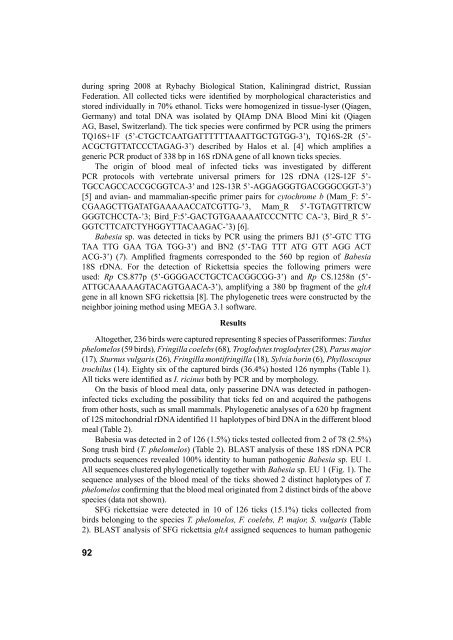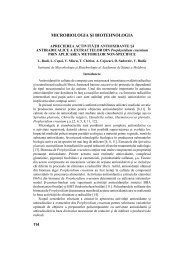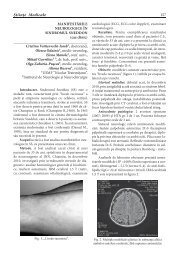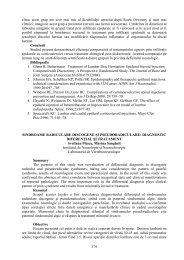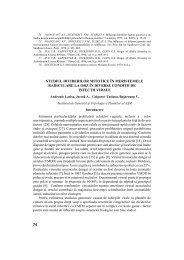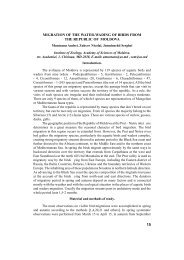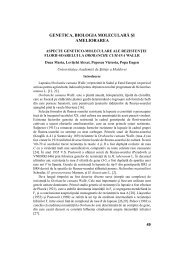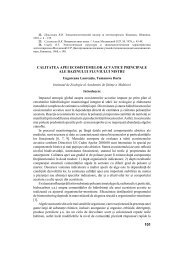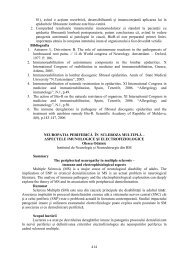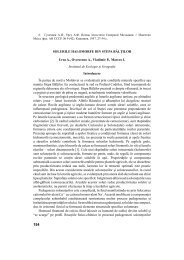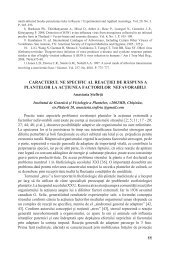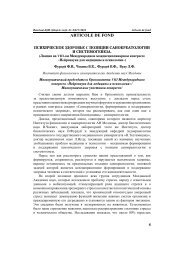198 CUPRINS
198 CUPRINS
198 CUPRINS
You also want an ePaper? Increase the reach of your titles
YUMPU automatically turns print PDFs into web optimized ePapers that Google loves.
during spring 2008 at Rybachy Biological Station, Kaliningrad district, Russian<br />
Federation. All collected ticks were identi ed by morphological characteristics and<br />
stored individually in 70% ethanol. Ticks were homogenized in tissue-lyser (Qiagen,<br />
Germany) and total DNA was isolated by QIAmp DNA Blood Mini kit (Qiagen<br />
AG, Basel, Switzerland). The tick species were con rmed by PCR using the primers<br />
TQ16S+1F (5’-CTGCTCAATGATTTTTTAAATTGCTGTGG-3’), TQ16S-2R (5’-<br />
ACGCTGTTATCCCTAGAG-3’) described by Halos et al. [4] which ampli es a<br />
generic PCR product of 338 bp in 16S rDNA gene of all known ticks species.<br />
The origin of blood meal of infected ticks was investigated by different<br />
PCR protocols with vertebrate universal primers for 12S rDNA (12S-12F 5’-<br />
TGCCAGCCACCGCGGTCA-3’ and 12S-13R 5’-AGGAGGGTGACGGGCGGT-3’)<br />
[5] and avian- and mammalian-speci c primer pairs for cytochrome b (Mam_F: 5’-<br />
CGAAGCTTGATATGAAAAACCATCGTTG-’3, Mam_R 5’-TGTAGTTRTCW<br />
GGGTCHCCTA-’3; Bird_F:5’-GACTGTGAAAAATCCCNTTC CA-’3, Bird_R 5’-<br />
GGTCTTCATCTYHGGYTTACAAGAC-’3) [6].<br />
Babesia sp. was detected in ticks by PCR using the primers BJ1 (5’-GTC TTG<br />
TAA TTG GAA TGA TGG-3’) and BN2 (5’-TAG TTT ATG GTT AGG ACT<br />
ACG-3’) (7). Ampli ed fragments corresponded to the 560 bp region of Babesia<br />
18S rDNA. For the detection of Rickettsia species the following primers were<br />
used: Rp CS.877p (5’-GGGGACCTGCTCACGGCGG-3’) and Rp CS.1258n (5’-<br />
ATTGCAAAAAGTACAGTGAACA-3’), amplifying a 380 bp fragment of the gltA<br />
gene in all known SFG rickettsia [8]. The phylogenetic trees were constructed by the<br />
neighbor joining method using MEGA 3.1 software.<br />
92<br />
Results<br />
Altogether, 236 birds were captured representing 8 species of Passeriformes: Turdus<br />
phelomelos (59 birds), Fringilla coelebs (68), Troglodytes troglodytes (28), Parus major<br />
(17), Sturnus vulgaris (26), Fringilla montifringilla (18), Sylvia borin (6), Phylloscopus<br />
trochilus (14). Eighty six of the captured birds (36.4%) hosted 126 nymphs (Table 1).<br />
All ticks were identi ed as I. ricinus both by PCR and by morphology.<br />
On the basis of blood meal data, only passerine DNA was detected in pathogeninfected<br />
ticks excluding the possibility that ticks fed on and acquired the pathogens<br />
from other hosts, such as small mammals. Phylogenetic analyses of a 620 bp fragment<br />
of 12S mitochondrial rDNA identi ed 11 haplotypes of bird DNA in the different blood<br />
meal (Table 2).<br />
Babesia was detected in 2 of 126 (1.5%) ticks tested collected from 2 of 78 (2.5%)<br />
Song trush bird (T. phelomelos) (Table 2). BLAST analysis of these 18S rDNA PCR<br />
products sequences revealed 100% identity to human pathogenic Babesia sp. EU 1.<br />
All sequences clustered phylogenetically together with Babesia sp. EU 1 (Fig. 1). The<br />
sequence analyses of the blood meal of the ticks showed 2 distinct haplotypes of T.<br />
phelomelos con rming that the blood meal originated from 2 distinct birds of the above<br />
species (data not shown).<br />
SFG rickettsiae were detected in 10 of 126 ticks (15.1%) ticks collected from<br />
birds belonging to the species T. phelomelos, F. coelebs, P. major, S. vulgaris (Table<br />
2). BLAST analysis of SFG rickettsia gltA assigned sequences to human pathogenic


